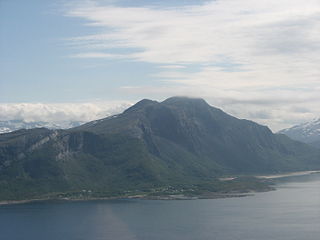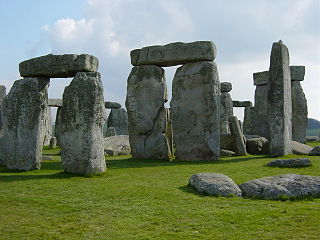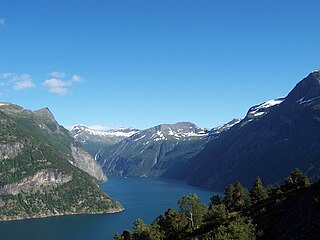
The discus throw is a track and field event in which an athlete throws a heavy disc—called a discus—in an attempt to mark a farther distance than his or her competitors. It is an ancient sport, as demonstrated by the fifth-century-BC Myron statue, Discobolus. Although not part of the modern pentathlon, it was one of the events of the ancient Greek pentathlon, which can be dated back to at least to 708 BC, and is part of the modern decathlon.

The pound or pound-mass is a unit of mass used in the imperial, United States customary and other systems of measurement. Various definitions have been used; the most common today is the international avoirdupois pound, which is legally defined as exactly 0.45359237 kilograms, and which is divided into 16 avoirdupois ounces. The international standard symbol for the avoirdupois pound is lb; an alternative symbol is lbm, #, and ℔ or ″̶.

Cod is the common name for the demersal fish genus Gadus, belonging to the family Gadidae. Cod is also used as part of the common name for a number of other fish species, and some species suggested to belong to genus Gadus are not called cod.

Pollock is the common name used for either of the two species of North Atlantic marine fish in the genus Pollachius. Pollachius pollachius is referred to as pollock in both North America and the United Kingdom, while Pollachius virens today is usually known as coley in the British Isles. Other names for P. pollachius include the Atlantic pollock, European pollock, lieu jaune, and lythe; while P. virens is also known as Boston blue, silver bill, or saithe.

The common carp or European carp is a widespread freshwater fish of eutrophic waters in lakes and large rivers in Europe and Asia. The native wild populations are considered vulnerable to extinction by the International Union for Conservation of Nature (IUCN), but the species has also been domesticated and introduced into environments worldwide, and is often considered a destructive invasive species, being included in the list of the world's 100 worst invasive species. It gives its name to the carp family Cyprinidae.
Long ton, also known as the imperial ton or displacement ton, is the name for the unit called the "ton" in the avoirdupois system of weights or Imperial system of measurements. It was standardised in the thirteenth century and is used in the United Kingdom and several other British Commonwealth of Nations countries alongside the mass-based metric tonne defined in 1799.

The twenty-foot equivalent unit is an inexact unit of cargo capacity often used to describe the capacity of container ships and container terminals. It is based on the volume of a 20-foot-long (6.1 m) intermodal container, a standard-sized metal box which can be easily transferred between different modes of transportation, such as ships, trains and trucks.
Human body weight refers to a person's mass or weight. Body weight is measured in kilograms, a measure of mass, throughout the world, although in some countries such as the United States it is measured in pounds, or as in the United Kingdom, stones and pounds. Most hospitals, even in the United States, now use kilograms for calculations, but use kilograms and pounds together for other purposes.

The stone or stone weight is an English and imperial unit of weight now equal to 14 pounds (6.35029318 kg).
The talent as a unit of weight was introduced in Mesopotamia at the end of the 4th Millennium BC, and was normalized at the end of the 3rd Millennium during the Akkadian-Sumer phase. It was divided into 60 minas, each of which was subdivided into 60 shekels. The use of 60 illustrates the attachment of the early Mesopotamians to their useful sexagesimal arithmetic. These weights were used subsequently by the Babylonians, Sumerians, and Phoenicians, and later by the Hebrews. The Babylonian weights are approximately: shekel, mina, and talent. The Phoenicians took their trade to the Greeks with their weight measures during the Archaic period, and the latter adopted these weights and their ratio of 60 minas to one talent; a Greek mina in Euboea around 800 B.C. was hence 504 gm, [See J.H. Kroll, Early Iron Age balance weights at Lefkandi, Euboea: Oxford Journal of Archaeology 27, pp. 37–48 (2008)]; other minas in the Mediterranean basin, and even Greek minas in other parts of Greece, varied locally in some small measure from the Babylonian values, and from one to another.

A heavy goods vehicle(HGV), also large goods vehicle (LGV) or medium goods vehicle, is the European Union (EU) term for any truck with a gross combination mass (GCM) of over 3,500 kilograms (7,716 lb). Sub-category N2 is used for vehicles between 3,500 kilograms (7,716 lb) and 12,000 kilograms (26,455 lb) and N3 for all goods vehicles over 12,000 kilograms (26,455 lb) as defined in Directive 2001/116/EC. The term medium goods vehicle is used within parts of the UK government to refer to goods vehicles of between 3.5 and 7.5 tonnes which according to the EU are also "large goods vehicles".

Stockfish is unsalted fish, especially cod, dried by cold air and wind on wooden racks on the foreshore. The drying of food is the world's oldest known preservation method, and dried fish has a storage life of several years. The method is cheap and effective in suitable climates; the work can be done by the fisherman and family, and the resulting product is easily transported to market.
Traditional Japanese units of measurement or the shakkanhō is the traditional system of measurement used by the people of the Japanese archipelago. It is largely based on the Chinese system, which spread to Japan and the rest of the Sinosphere in antiquity. It has remained mostly unaltered since the adoption of the measures of the Tang Dynasty in AD 701. Following the Meiji Restoration, Imperial Japan adopted the metric system and defined the traditional units in metric terms on the basis of a prototype metre and kilogram. The present values of most Korean and Taiwanese units of measurement derive from these values as well, owing to their occupations by the Japanese.

The Australian bonito, horse mackerel or little bonito, Sarda australis is a fish of the family Scombridae and is found in eastern Australia and New Zealand. They swim at depths reaching depths of approximately 30 m (98 ft), in open water. Its length is commonly at around 40–45 centimetres (16–18 in) fork length and 1.8–2.3 kilograms (4.0–5.1 lb) weight. Its maximum length and weight are about 100 centimetres (39 in) and 9.4 kilograms (21 lb), respectively.

Sandhornøya or Sandhornøy is a mountainous island in the municipality of Gildeskål in Nordland county, Norway. The 103-square-kilometre (40 sq mi) island is located south of the town of Bodø near the entrance to the Saltfjorden. The mainland of Norway lies to the east and the islands of Fleina, Sørarnøya, and Nordarnøya lie to the west. The villages of Lekanger, Mårnes, and Våg are located on the island. The island is connected to the mainland by the Sandhornøy Bridge. Sandhornøy is also the birthplace of famous Norwegian professor and hymn writer, Elias Blix. A memorial monument of Blix can be seen by the coastline.

Oxydoras is a genus of thorny catfishes native to tropical South America.

Cod fisheries are fisheries for cod. Cod is the common name for fish of the genus Gadus, belonging to the family Gadidae, and this article is confined to the three species that belong to this genus: the Atlantic cod, the Pacific cod and the Greenland cod.

The 21 cm Kanone 39 was a Czech-designed heavy gun used by the Germans in the Second World War. Two were built before the Germans occupied Czechoslovakia in March 1939 and seized the rest of the guns and kept it in production for their own use, eventually building a total of 60 guns for themselves. They saw action in Operation Barbarossa, the Siege of Odessa, Siege of Leningrad and the Siege of Sevastopol and were used on coast defence duties.

The History of Shetland concerns the subarctic archipelago of Shetland in Scotland. The early history of the islands is dominated by the influence of the Vikings. From the 14th century it was incorporated into the Kingdom of Scotland, and later into the United Kingdom.

Class A Wild Trout Waters are the highest biomass class given to streams in Pennsylvania by the Pennsylvania Fish and Boat Commission. They are considered to contain the highest-quality naturally reproducing trout populations in Pennsylvania. The first streams received their Class A Wild Trout Waters designations in 1983. There are now hundreds of such waters, comprising nearly 1,500 miles (2,400 km) of streams. Class A Wild Trout Waters receive certain legal protections. For instance, they are typically classified by the Pennsylvania Department of Environmental Protection as High-Quality Coldwater Fisheries. Most Class A Wild Trout Waters are subject to standard statewide angling regulations by the Pennsylvania Fish and Boat Commission.



















